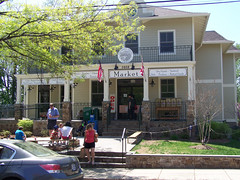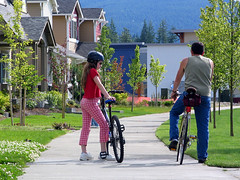The popsicle test, the Halloween test, and neighborhoods for kids

Posted August 22, 2011 at 3:24PM
In a recent post on his firm’s excellent blog, PlacesShakers and NewsMakers, Scott Doyon reminds us of the “popsicle test” of a well-designed neighborhood:  if an 8-year-old kid can safely go somewhere to buy a popsicle, and get back home before it melts, chances are it’s a neighborhood that works. Note that there’s no planning jargon in there: nothing explicitly about mixed uses, or connected streets, or sidewalks, or traffic calming, or enough density to put eyes on the street. But, if you think about it, it’s all there.
if an 8-year-old kid can safely go somewhere to buy a popsicle, and get back home before it melts, chances are it’s a neighborhood that works. Note that there’s no planning jargon in there: nothing explicitly about mixed uses, or connected streets, or sidewalks, or traffic calming, or enough density to put eyes on the street. But, if you think about it, it’s all there.
I’m also fond of the “Halloween test”: if it’s a good neighborhood for trick-or-treating, then it’s likely to be compact and walkable. My brother-in-law, who lives in a place that is anything but, drives his kids to the nearest traditional town center on Halloween. Quite a few parents seem to do the same thing by driving to my neighborhood.
Scott puts it this way:
“For a child, having increasing opportunities to navigate the world around them, explore, invent, fall down, scrape knees, make decisions, screw up, get into — and solve — conflicts and, ultimately, achieve a sense of personal identity and self-sufficiency is a good thing. The right thing.
“But you can’t do it easily just anywhere. Place matters. It matters in the design of the streets and the things they connect to. It matters in the variety of uses, opportunities and activities. It even matters in the diversity of housing types. After all, smaller homes or accessory units end up housing people who appreciate, and want to be able to afford, the prospect of being a stay-at-home parent. Or seniors offering options for drop-off babysitting. Not because it’s their corporate value proposition and you’re paying them a thousand bucks a month but because they’re your neighbors and they care about you . . .
"Talk of how it takes a village to raise a child sounds — and feels — good but, to make it work, you need a village to start with. Which means you need politicos willing to push it, and developers willing to build it.”
Pretty good observation, that one. If the place works for kids, chances are it works for everyone else, too (and, not coincidentally, it also works for the environment) –  but as we build new places, or rebuild old ones, we need to be purposeful about it.
but as we build new places, or rebuild old ones, we need to be purposeful about it.
I’ve always been struck by a statistic that’s probably now at least a decade old, to the effect that suburban moms spend the equivalent of 17 full days each year driving their kids around, more time than an average person spends bathing and feeding a child. When I was a kid, I explored places, hanging out with my friends. I walked to the tennis courts and quickly became addicted to a sport I played for 30 years. I took the bus places. My parents drove me somewhere maybe once or twice a week, max.
I’m not sure I know a single kid who lives that way now – everything is scheduled, and everything requires a car trip, even just to get to school. That really seems out of whack with what growing up should be about, and a lot of it has to do with how we constructed our built environment over the last few decades, assuming unlimited driving was a fine way to live.
It isn’t.
Am I now just an old codger who thinks things were better back in my day? (Those who know me, please don’t answer that. Thanks.) Well, Scott is a lot younger than me, and he agrees. I think he’s on to something.
Publication of the blog will be reduced (but not stopped) while I am on vacation, until after Labor Day.
Move your cursor over the images for credit information.

